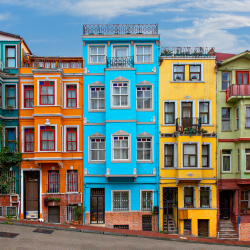The Chora Museum, located in the Edirnekapi district of Istanbul, is a renowned historical landmark. This former Byzantine church boasts some of the finest surviving examples of Byzantine mosaics and frescoes, offering a glimpse into the rich artistic and religious heritage of the Byzantine Empire.
 The museum's interior is adorned with intricate mosaics and frescoes that depict biblical scenes, saints, and the Virgin Mary. These masterpieces, dating back to the 14th century, are renowned for their vibrant colors, exquisite details, and emotional depth. Visitors can marvel at the iconic figures of Christ Pantocrator, the Virgin Mary, and various saints, as well as the intricate geometric patterns and floral motifs that adorn the walls and ceilings.
The museum's interior is adorned with intricate mosaics and frescoes that depict biblical scenes, saints, and the Virgin Mary. These masterpieces, dating back to the 14th century, are renowned for their vibrant colors, exquisite details, and emotional depth. Visitors can marvel at the iconic figures of Christ Pantocrator, the Virgin Mary, and various saints, as well as the intricate geometric patterns and floral motifs that adorn the walls and ceilings.
The Chora Museum's collection also includes a variety of other artifacts, such as marble sculptures, ceramic tiles, and architectural fragments. These objects provide further insights into the history and culture of the Byzantine period.
The museum's serene atmosphere and stunning artwork make it a must-visit destination for art and history enthusiasts. It offers a unique opportunity to appreciate the beauty and complexity of Byzantine art and to connect with the spiritual and cultural significance of this bygone era.
Historical Transformation of Chora Church
It is not clear how old is Chora Church but records show that it was first built in the 5th century, so the church is almost 1600 years old. The question of when was Chora Church built has its answer in the construction process. After the original church was destroyed by an earthquake, it had to wait for seven centuries to be rebuilt by Byzantine Emperor. The name Chora has a connotation with the Greek word meaning the countryside. At the time of its first construction, Chora Church was out of the city walls, however with the expansion of these walls, the monastery area remained within the city. Therefore, its re-construction got the importance but its name remained unchanged. This area in Edirnekapı is recently called ¨Kariye¨ - a modified version of original ¨chora¨ in the Turkish language.
After the conquest of Istanbul by Turks in 1453, Chora Church was transformed into Kariye Mosque by adding a mihrab and a minaret to the structure. The frescoes were just covered but not destroyed so that they could survive until today. After the Second World War, a restoration plan was implemented and all the Chora Church frescoes and mosaics were uncovered to revive it as Kariye Museum.
Chora Church Frescoes and Mosaics
The reason why Chora Church is significant has a connection with Chora Church facts. First of all, the structure was rebuilt by Aleksios Comnenus in the 11th century and restored in the 12th century when most of the mosaics reflecting Biblical stories were added. The sponsor of this great work Comnenus was reflected in one of the mosaics as a company to the Virgin Mary. Chora Church architecture is a typical example of Orthodox churches with Byzantine style.
The majority of Chora Church frescoes were decorated by imperial artist Theodore Metochites in the 14th century. These outstanding frescoes describe the Old and New Testament as well as the episodes from Jesus Christ’s life. The Anastasis in Chora Church is the most remarkable one portrayed on the right chapel. Anastasis or Anastasios means ¨resurrection¨ in Koine Greek and the fresco is a beautiful masterpiece reviving the scene of Christ’s resurrection.

Chora Church in Istanbul is usually compared to Church Chora Folegandros in Italy, which also depicts the Dormition of Virgin Mary in its mosaics; yet, the former is smaller in size but the frescoes and mosaics appear greater. They seem much closer and more vivid in color due to the sunlight oozing through windows.
Visitor’s Guide to Chora Church
Buy your online tickets for Chora Museum on Istanbul.com with ease and get a specially curated audio guide with your ticket. Chora Church Istanbul's hours allow visitors to enjoy the overall work of art from 09:00 to 16:30 in winter whereas extending the time up to 18:00 on summer days. Istanbul.com offers tickets to enjoy the time in various remarkable places from Chora Church to Hagia Sophia Mosque, from Istanbul City Walls to the Golden Horn. In this sense, Byzantine Monasteries of Istanbul is a specifically designed tour for visitors who would like to have a deeper insight into Byzantine arts reflected on stone houses, and columns with the highlight of the Chora Church to fulfill the artistic power of mosaics and frescoes.
 English
English  Indonesian
Indonesian  Urdu
Urdu  Taiwanese
Taiwanese  Russian
Russian  Romanian
Romanian  Portuguese
Portuguese  Persian
Persian  Macedonian
Macedonian  Korean
Korean  Japanese
Japanese  Italian
Italian  Indian
Indian  Hungarian
Hungarian  Greek
Greek  German
German  Croatian
Croatian  Chinese
Chinese  Bulgarian
Bulgarian  Arabic
Arabic  French
French  Spanish
Spanish 
 The museum's interior is adorned with intricate mosaics and frescoes that depict biblical scenes, saints, and the Virgin Mary. These masterpieces, dating back to the 14th century, are renowned for their vibrant colors, exquisite details, and emotional depth. Visitors can marvel at the iconic figures of Christ Pantocrator, the Virgin Mary, and various saints, as well as the intricate geometric patterns and floral motifs that adorn the walls and ceilings.
The museum's interior is adorned with intricate mosaics and frescoes that depict biblical scenes, saints, and the Virgin Mary. These masterpieces, dating back to the 14th century, are renowned for their vibrant colors, exquisite details, and emotional depth. Visitors can marvel at the iconic figures of Christ Pantocrator, the Virgin Mary, and various saints, as well as the intricate geometric patterns and floral motifs that adorn the walls and ceilings.



